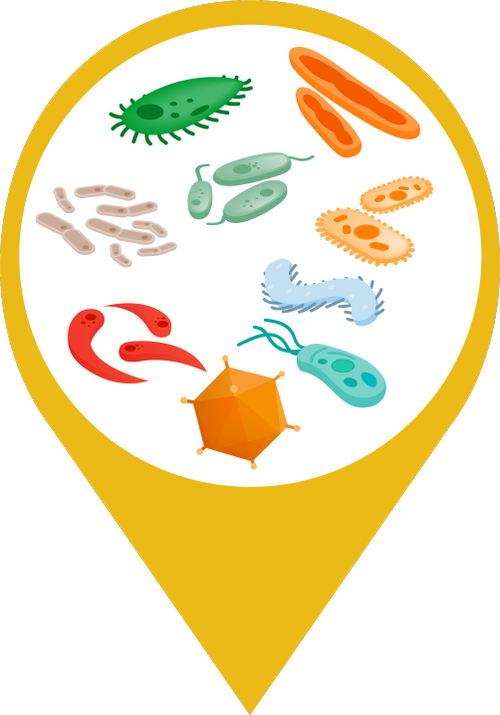Microorganisms
Also known as microbial contaminants, microbes, pathogens, water-borne illness, fecal coliforms. 
What are they?
Microorganisms are microscopic organisms transmitted via water from one host to another. They include: bacteria, viruses, protozoans and other parasites. Many microorganisms in water do not harm humans or animals, but there are a number that can cause serious illness. Examples of illnesses caused by microorganisms in drinking water are: Escherichia coli (E. coli), cholera, beaver fever (giardiasis), typhoid fever, swimmer’s itch and salmonella.
Are microorganism in water regulated in Alberta?
Yes, microorganisms are monitored and regulations are in place to limit the microorganisms in source water and effluent water. Municipal water in North America is treated and tested specifically for microorganisms. Regulations limit the number of microorganisms released in effluent from wastewater treatment plants, and the concentration of microorganisms that are in wastewater or runoff water from industry and agriculture.
Are micro-organisms in my water?
Source water
Yes, there are microorganisms in surface water in Alberta. If you are recreating in and around a natural water source, or if you are hiking in the mountains, it is important to be aware that there can be microorganisms, even in clean-looking water. See our tips on what you can do about microorganisms in the water.
Tap Water
No, there should be no microorganisms in your tap water.
A public drinking-water advisory will be in place if your water supply is not safe to drink. If you have a private well or live in an area without a water treatment plant (e.g., in an on-reserve Indigenous community or a rural private property), the tap water may need to be disinfected with chlorine, UV light, or another method to kill the microorganisms.
Many rural residents source their drinking water from a well on their property. Water wells in Alberta are sealed and protected against microorganism contamination and the Alberta Government provides suggestions and some testing support to keep private well water safe for drinking.
What are the impacts on human health?
Every year, people in Alberta get illnesses caused by microorganisms in the water. The health system treats around 400 people for giardiasis (an intestinal infection caused by Giardia, a protozoan parasite) and around 100 people for cryptosporidiosis (an infection caused by Cryptosporidium). In most cases the illness is not life threatening and requires standard medical treatment. See our misconceptions page on Pristine Headwaters to learn more about these organisms and ways to avoid infection.
What are the impacts on the environment?
Microorganisms are a natural part of ecosystems, and do not typically have negative impacts on the environment. Microorganisms, while unseen, are an essential element of biodiversity. They are critical for nutrient cycling, among other things.
How do micro-organisms get into the water?
Unsafe microorganisms can enter rivers or lakes when sewage leaks from a septic system, or rain washes animal feces into the water. Also, if animals or people defecate on top of snow or ice in the winter, by springtime the snowmelt carries the faeces into the water.
Confined Feeding Operations (CFOs), especially of cattle, result in large amounts of manure with very high concentrations of microorganisms. If the manure is not managed properly, nearby waterways can become contaminated by these microorganisms as well as nutrients.
What can we do about micro-organisms in the water?
Because microorganisms are potentially dangerous, there are many protocols already in place to keep them out of the tap water. That said you can also:
- Keep microorganisms out of the waterways by cleaning up after dogs.
- Ensure septic tanks and sewage lines are operating properly and are not leaking.
- Use public restrooms or follow instructions in parks for burial of feces away from watercourses.
- Filter or boil your water if you are collecting it from a river, stream or lake.
- Avoid swallowing water when swimming in a lake or river, and be aware of posted warnings regarding swimmer’s itch or fecal coliforms. Alberta Health Services posts public health advisories on signs at the water site itself, online, or through other media.
Where can I find more information?
Alberta Health Services active advisories
Understanding your Drinking Water test Results
Guidelines for microorganisms in recreational water. Table 3 Pg. 46
Federal government – Guidelines for Canadian Recreational Water Quality
The City of Calgary Drinking Water
The State of the Watershed
Sources:
Government of Alberta (2015) Alberta Notifiable Disease Incidence: a historical record 1919–2014. https://open.alberta.ca/dataset/09ff0f40-1cfc-48fd-b888-4357104c3c32/resource/c5ceca04-ccda-4811-9ed0-03a3cbe8c0fb/download/7019844-Notifiable-Disease-Incidence-1919-2014.pdf
Government of Alberta (2004). Notifiable Diseases in Alberta, 2004 annual report. https://open.alberta.ca/dataset/5fd36f25-96f3-41c6-b08c-55028ed19646/resource/7ac9cb00-5f6e-404e-b9cb-6752a5cce38d/download/Notifiable-Diseases-Report-2004.pdf
Government of Canada (2017). Guidelines for Canadian Drinking Water Quality – Summary table. https://www.canada.ca/en/health-canada/services/environmental-workplace-health/reports-publications/water-quality/guidelines-canadian-drinking-water-quality-summary-table-health-canada-2012.html#t1
Government of Alberta (2013) Part 3 Wastewater Systems Standards for Performance and Design of a total of 5 Parts. Microorganism limits in effluent water. Tables 3.1 and 3.2. In Standards and Guidelines for Municipal Waterworks, wastewater and Storm Drainage Systems. http://aep.alberta.ca/water/programs-and-services/drinking-water/legislation/documents/Part3-WastewaterSystemsStandards-2013.pdf
Alberta Agriculture and Forestry (2017, May 3). Protecting Your Well From Contamination. http://www1.agric.gov.ab.ca/$department/deptdocs.nsf/all/wwg413
Alberta Environment and Parks (2017. March 28). Surface Water Quality Data. http://aep.alberta.ca/water/reports-data/surface-water-quality-data/default.aspx
Alberta Agriculture and Forestry (2017). Benficial Management Practices: Environmental Manual for Crop Producers in Alberta – Water Quality. http://www1.agric.gov.ab.ca/$department/deptdocs.nsf/all/agdex9317
